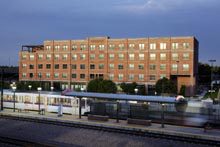A consequence of huge transit expansions is that nearby rentals and other housing tend to escalate in cost, and lower income residents—who may have lived their entire lives in the same neighborhood—can get priced out. A recent report from the Metropolitan Area Planning Council warns that, for example, rents for apartments near the new Green Line stations in the ever-gentrifying Boston suburb of Somerville could rise as much as 67 percent—even before the new stops open.
Equitable transit oriented development (TOD) aims to prevent this by including housing that’s affordable to local residents in the development plan early on, and assuring that it remains so for decades to come.
“If you allow change to just happen, you run the risk of wholesale displacement of low-income folks,” says Tony Pickett, a key player in efforts to include long-term affordable housing in two of the nation’s largest TOD ventures: Denver’s FasTracks plan and Atlanta’s Beltline project. “We’re working to avoid that.”
Pickett joined Denver’s nonprofit Urban Land Conservancy (ULC) last October as vice president of master site development. The organization worked with Enterprise Community Partners, the city and county of Denver, and other investors to establish the first affordable housing TOD acquisition fund in the country.
The purpose of the Denver TOD Fund is to support the creation and preservation of over 1,000 affordable housing units strategically located near transit, as the region builds 122 new miles of rail lines through the FasTracks plan. ULC’s primary role is strategic property acquisition and land assembly, and they oftentimes partner with other organizations— both nonprofit and for-profit—to develop those properties. At times, the ULC also functions as a community land trust, by retaining long-term ownership and stewardship of the land, ensuring the property will benefit the community for generations.
As an example, at Sheridan Station on the FasTracks West Rail Line (which connects downtown Denver to Golden) ULC purchased land beneath the 62-unit Jody Apartments in 2007—prior to the line opening. It did so in partnership with NEWSED, a Denver-based community development corporation. The ULC owns the two acres of land, and NEWSED owns and operates the units under a 99-year land lease. (See here for an explanation of the “ground lease” as a tool for permanent affordability.)
Fifty-two of the 62 apartments are permanently affordable. The plan is to build up to 200 units, in multiple phases, on both the existing property and an adjacent two acres recently acquired by the ULC. The first phase of the new apartments will include at least 62 permanently affordable units, so that no residents will be displaced once the Jody Apartments (which the ULC says are in need of replacement) are torn down.
Before joining the ULC, Pickett was the founding executive director of the Atlanta Land Trust Collaborative, and led efforts to create equitable development along the multi-billion Atlanta Beltline project. He says there are several similarities between Denver and Atlanta. “Both are dealing with suburbanization of poverty, TOD-sponsored change happening in the urban core, and the impact that has on low-income populations,” says Pickett. “And in both places, there’s a focus on multifamily rentals.”
There are major differences between the two cities as well. “In Denver, there’s more acceptance of community land trusts. In Atlanta, CLTs were virtually unknown,” says Pickett. “There were a lot of concerns and questions, like: ‘Are you limiting the wealth-building capacity of low-income communities?’” (Hint: The Answer is no.)
Regarding financing, with no TOD Fund, the affordable housing work in Atlanta was reliant on individual government programs and lending institutions that deal with non-profit and for-profit developers to supply operating capital, land acquisition, and construction financing. That contrasts sharply with the situation in Denver, says Pickett, where the ULC has access to a unique collective fund pool. Local government, foundations and private banks—Wells Fargo, First Bank, and US Bank—collaborate to help finance strategic land acquisition. “They understand the importance of affordable housing at transit stations,” he says. “They’re also the lending partners for our developers. It’s a business opportunity for them.”
Pickett says another one of the ULC’s important allies is the well-established collaborative group, Mile High Connects. Its members—investors in the TOD fund, philanthropic organizations, and nonprofit partners—consider transit-oriented development from a variety of perspectives, including health and employment. “They’re having open discussions, reaching consensus, and focusing everyone’s efforts on achieving long-term benefit for the local residents,” says Pickett. “It’s a tremendous asset.”
As for the future, Pickett says the ULC will continue to build-out its current TOD acquisition portfolio, which includes eight sites. The largest is the 9.4 acre Park Hill Village West, a mixed-use development that includes open space, affordable housing, opportunities for resident employment, and priority for local businesses. Pickett says there’s potential to develop up to 450 new housing units at the site, and the ULC is hoping to use a long-term ground lease beginning with the second phase of construction, to create hundreds of long-term affordable units.
The ULC is also acquiring land at two stations on the East Rail Line, which will lead from the downtown business district to the Denver International Airport. Pickett says a variety of stations along the line go through at-risk neighborhoods, and his group plans to use a long-term ground lease to build permanently affordable units in those areas.
After years of promoting equitable transit-oriented development, Pickett, who moved to Denver last October, is, for the first time, reaping the benefits himself. He rents an apartment in a diverse, mixed-income neighborhood that includes permanently affordable units, and lives within walking distance of his office, light rail, a park, a grocery store, and other essential services. “It’s quite pleasant, and I already feel healthier,” says Pickett. “I’m living the TOD lifestyle here, and I’m excited to help create new communities that offer people—across a range of incomes—the opportunity to do the same.”
Read more from Pickett about his work in Denver and Atlanta in a Shelterforce exclusive interview.





Comments